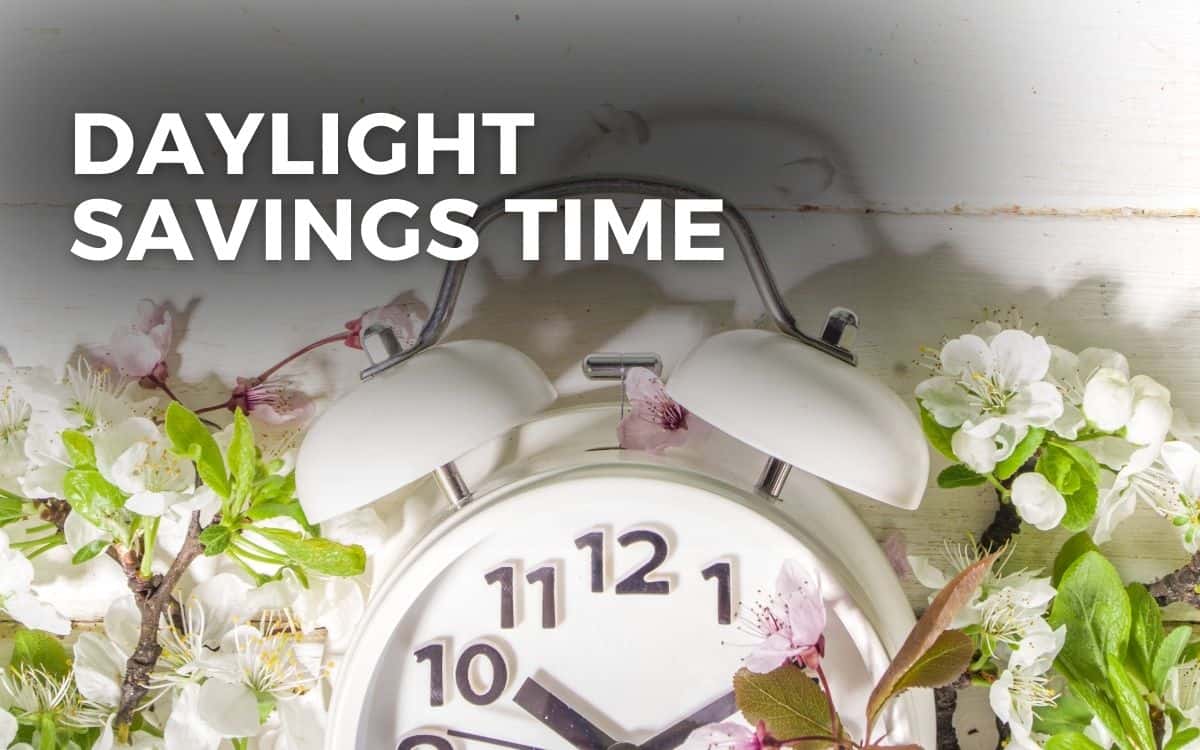Daylight Savings Time is March 10th. Are you tired of springing forward and falling back every year, never quite understanding the purpose behind Daylight Savings Time? Well, prepare to have your curiosity piqued and your understanding deepened as we unravel the history and significance of this biannual time change. From its origins to its modern-day implications, we will explore the reasons behind Daylight Savings Time and its impact on various aspects of our lives. So, get ready to discover the hidden secrets of this time-honored tradition and gain a fresh perspective on how it affects you.

*Disclosure: This post contains affiliate links. If you make a purchase using one of these links, I may receive a small commission. Please know that I only recommend products I have used and that I sincerely think will help your business
When is Daylight Savings Time?
Make sure you mark your calendars for the upcoming time change known as Daylight Savings Time. Daylight Savings Time, also known as DST, is a system where the clocks are adjusted forward by one hour in the spring and backward by one hour in the fall. This adjustment is made to maximize daylight during the evenings and to make better use of natural sunlight. So, when exactly does Daylight Savings Time occur?
In most parts of the United States, Daylight Savings Time starts on the second Sunday in March and ends on the first Sunday in November. This means that in the spring, we set our clocks forward by one hour, usually at 2:00 a.m., to 3:00 a.m. This results in longer evenings and shorter mornings. Then, in the fall, we set our clocks back by one hour, usually at 2:00 a.m., to 1:00 a.m. This gives us shorter evenings and longer mornings.
It’s important to note that not all states in the United States observe Daylight Savings Time. Hawaii and most of Arizona do not participate in the time change. Additionally, the start and end dates of Daylight Savings Time can vary in other countries. So, if you have family or business contacts outside of the United States, it’s a good idea to check the specific dates for their location.
Now that you know when Daylight Savings Time occurs, you can plan accordingly. Remember to set your clocks forward in the spring and back in the fall to ensure you’re in sync with the time change. It’s a small adjustment that can have a big impact on how you structure your days and take advantage of the extra daylight.
History of Daylight Savings Time
Now let’s take a quick look at the history of Daylight Savings Time. You may be surprised to learn that this practice dates back to the early 20th century. It was first implemented as a way to conserve energy during World War I, but its popularity fluctuated over the years.
Daylight Saving Time (DST) has a history rooted in the pursuit of energy conservation and maximizing daylight hours for economic and social benefits. The concept of DST dates back to the early 20th century when it was first proposed by entomologist George Vernon Hudson in 1895 and later advocated for by British builder William Willett in 1907. However, it was not until World War I that DST was implemented on a widespread scale, with countries such as Germany and the United Kingdom adopting it as a means to conserve energy during wartime.
The rationale behind DST lies in adjusting clocks forward in the spring to extend evening daylight hours and backward in the fall to provide more daylight in the mornings. This practice aims to reduce energy consumption by minimizing the need for artificial lighting during the longer daylight hours of the evening. Over the years, DST has been both praised and criticized for its effects on energy usage, public health, and economic activity. Despite its contested history and varying levels of adoption worldwide, DST continues to be observed in many countries today, with the transition between standard time and DST occurring biannually in most regions.
How to Celebrate Daylight Savings Time
Ready to make the most of Daylight Savings Time? Here are some simple ways you can celebrate: as an individual, take advantage of the extra daylight by going for a walk or enjoying outdoor activities; as a business, consider hosting a special event or offering discounts to attract customers during the longer evenings. Embrace the time change and make it a memorable experience for yourself and your business.
How Individuals Can Celebrate Daylight Savings Time
Looking for ways to celebrate Daylight Savings Time?
Here are five ways individuals can celebrate Daylight Saving Time:
- Enjoy Outdoor Activities: Take advantage of the longer daylight hours by spending time outdoors. Go for a hike, have a picnic in the park, or enjoy outdoor sports like soccer or cycling. Daylight Saving Time provides extra daylight in the evenings, making it perfect for outdoor recreation.
- Start a New Hobby: Use the extra daylight to explore a new hobby or activity. Whether it’s gardening, painting, photography, or learning a musical instrument, longer daylight hours provide more time to pursue interests and hobbies.
- Spring Cleaning: Use the transition to Daylight Saving Time as an opportunity to declutter and organize your living space. Open the windows, let in the sunlight, and tackle tasks like cleaning out closets, tidying up the garage, or deep cleaning your home.
- Set Goals and Plans: Use the shift in time as a chance to reset and set new goals or plans. Whether it’s personal goals, fitness goals, or professional aspirations, take advantage of the extra daylight to plan and make progress towards achieving your objectives.
- Adjust Sleep Schedule: With the clocks springing forward, adjust your sleep schedule to ensure you get enough rest. Gradually shift your bedtime earlier in the days leading up to the time change to help ease the transition and minimize the impact on your sleep. Use the extra daylight in the evenings to unwind and relax before bedtime.
How Businesses Can Celebrate Daylight Savings Time
Are you a small business owner looking to celebrate Daylight Savings Time? Here are five ways a business can celebrate Daylight Saving Time:
- Host a Spring Sale: Capitalize on the excitement of longer daylight hours by hosting a spring sale or promotion. Offer discounts on seasonal products or services, and use the extra daylight as a marketing angle to encourage customers to shop or engage with your business.
- Extend Business Hours: Take advantage of the longer daylight hours by extending your business hours. Consider staying open later in the evening to accommodate customers who may want to shop or visit your establishment after work. Promote extended hours through social media, email newsletters, and signage to attract customers.
- Launch a Daylight Savings Time Campaign: Create a marketing campaign centered around Daylight Saving Time to engage with your audience. Use the theme of “springing forward” or “gaining an extra hour of daylight” to promote relevant products or services. Offer special deals or incentives to encourage customer participation and drive sales.
- Organize Outdoor Events: Plan outdoor events or activities to celebrate the arrival of longer daylight hours. Host a spring-themed festival, outdoor concert, or sidewalk sale to attract customers and create a festive atmosphere. Use social media and local advertising to promote the event and draw in attendees.
- Promote Wellness Initiatives: Emphasize the importance of self-care and wellness during the transition to Daylight Saving Time. Offer wellness workshops, yoga classes, or meditation sessions to help customers adjust to the time change and alleviate any stress or fatigue. Position your business as a supportive and caring resource for the community during this time of transition.
Social Media Post Ideas for Daylight Savings Time
Looking for some fresh ideas for your social media posts on Daylight Savings Time? Look no further! We’ve got you covered with a variety of post ideas that both individuals and businesses can use to engage their audience and make the most out of this time change. Get ready to boost your social media presence and connect with your followers like never before!
Social Media Post Ideas for Individuals to Use on Daylight Savings Time
Are you looking for creative ways to engage your audience on social media during Daylight Savings Time? Here are five ways individuals can use social media posts for Daylight Saving Time:
- Share Tips for Adjusting: Create posts offering tips and advice on how to adjust to the time change smoothly. Share strategies for resetting sleep schedules, maximizing daylight hours, and managing energy levels during the transition.
- Highlight Outdoor Activities: Showcase outdoor activities and adventures that take advantage of the longer daylight hours. Share photos or videos of scenic hikes, bike rides, or outdoor picnics, and encourage followers to get outside and enjoy the extra daylight.
- Promote Productivity Tips: Share productivity tips and hacks to help followers make the most of the longer days. Offer advice on time management, goal-setting, and staying focused during the transition to Daylight Saving Time.
- Encourage Self-Care: Advocate for self-care and well-being during the time change. Share posts promoting relaxation techniques, mindfulness practices, and self-care rituals to help followers unwind and de-stress during this period of adjustment.
- Create Engaging Polls or Quizzes: Foster engagement with interactive polls or quizzes related to Daylight Saving Time. Ask followers about their favorite ways to spend extra daylight, their preferred sleep strategies, or their thoughts on the time change. Use the results to spark conversations and connect with your audience.
Social Media Post Ideas for Businesses to Use on Daylight Savings Time
Looking to engage your audience and boost your business on Daylight Savings Time? Here are five ways a business can use social media posts for Daylight Saving Time:
- Share Tips for Adjusting: Create social media posts offering helpful tips and advice for adjusting to the time change. Offer suggestions for resetting sleep schedules, maximizing productivity during the longer daylight hours, and coping with any disruptions to daily routines.
- Offer Promotions or Discounts: Use social media to announce special promotions or discounts tied to Daylight Saving Time. Offer “spring forward” deals or discounts on products or services to incentivize customers to shop or engage with your business during the transition period.
- Host Contests or Giveaways: Drive engagement on social media by hosting contests or giveaways related to Daylight Saving Time. Encourage followers to share their favorite tips for adjusting to the time change or their plans for making the most of the longer days. Offer prizes or rewards to participants to incentivize participation and increase brand visibility.
- Create Relevant Content: Develop social media content that resonates with your audience during Daylight Saving Time. Share posts featuring spring-themed imagery, inspirational quotes, or seasonal tips and ideas. Tailor your content to reflect the positive aspects of the time change and the arrival of spring.
- Educate Your Audience: Use social media to educate your audience about the history and purpose of Daylight Saving Time. Share informative posts explaining why we “spring forward” and the potential benefits of the time change. Help your followers understand how Daylight Saving Time impacts their daily lives and how they can make the most of the transition.
Want to create social media content 10X faster? Start your free 7-day trial of the Social Media Content Club and say goodbye to social media stress.
Hashtags to Use During Daylight Savings Time
Are you looking to boost your social media presence during Daylight Savings Time? Look no further than these 10 hashtags that are perfect for capturing the spirit of the time change.
- #DaylightSavingTime
- #SpringForward
- #DST
- #TimeChange
- #ExtraDaylight
- #AdjustingToDST
- #LongerDays
- #TimeSpringForward
- #SpringTime
- #TimeShift
- #DaylightHours
- #SpringAhead
- #TimeAdjustment
- #DSTTransition
- #ClocksForward
For the complete list of holidays to celebrate on social media in March, visit AngieGensler.com/March-Holidays.
Gift Ideas for Daylight Savings Time
Looking for the perfect gift to celebrate Daylight Savings Time? Look no further!
- Wake-Up Light Alarm Clock: Gift a wake-up light alarm clock that simulates the sunrise to help ease the transition to earlier wake-up times during Daylight Saving Time.
- SAD Lamp: Give a SAD lamp, also known as a light therapy lamp, to help combat the effects of decreased sunlight during the darker mornings of Daylight Saving Time.
- Sleep Mask Set: Offer a sleep mask set with comfortable, adjustable masks to help block out early morning light and promote restful sleep during the transition period.
- Essential Oil Diffuser: Provide an essential oil diffuser with calming scents like lavender or chamomile to create a relaxing atmosphere for bedtime during Daylight Saving Time.
- Journal or Planner: Present a journal or planner to help organize schedules and track daily activities during the adjustment to Daylight Saving Time, offering a sense of control and productivity during the transition period.
Other Holidays Related to Daylight Savings Time
As a small business owner, you may be wondering what other holidays are related to Daylight Savings Time. Well, here are five holidays that you can incorporate into your business celebrations:
- Spring Equinox: Observed around March 20th, the Spring Equinox marks the beginning of spring in the Northern Hemisphere and aligns with the transition to Daylight Saving Time, symbolizing the return of longer days and warmer weather.
- National Sleep Awareness Week: Celebrated annually in March, National Sleep Awareness Week raises awareness about the importance of healthy sleep habits and coincides with the adjustment to Daylight Saving Time, emphasizing the significance of maintaining consistent sleep schedules.
- National Relaxation Day: Recognized on August 15th, National Relaxation Day promotes relaxation and stress relief, offering an opportunity to unwind and recharge, particularly after the disruptions to sleep patterns caused by the time change associated with Daylight Saving Time.
- International Day of Happiness: Celebrated on March 20th, the International Day of Happiness encourages individuals to prioritize happiness and well-being, coinciding with the arrival of longer daylight hours following the transition to Daylight Saving Time, which can positively impact mood and energy levels.
- National Napping Day: Observed on the Monday after the start of Daylight Saving Time in March, National Napping Day recognizes the importance of taking short naps to compensate for lost sleep and adjust to the time change, offering a practical solution for combating fatigue and drowsiness.
For more holidays, download our free calendar with over 1,000 fun and unique holidays to celebrate this year. Head to angiegensler.com/holiday-calendar to grab your free copy!
Future Dates for Daylight Savings Time
Now let’s take a look at the future dates for Daylight Savings Time.
| Year | Month | Day |
|---|---|---|
| 2024 | March 10 | Sunday |
| 2025 | March 9 | Sunday |
| 2026 | March 8 | Sunday |
| 2027 | March 14 | Sunday |
| 2028 | March 12 | Sunday |
| 2029 | March 11 | Sunday |
Frequently Asked Questions
Are you curious about Daylight Savings Time? Have questions about how it works or why we have it? Well, you’re in luck because this section is all about answering those frequently asked questions. So, let’s dive right in and get the answers you’re looking for!
- Why do we have Daylight Saving Time? Daylight Saving Time was implemented to make better use of daylight during the longer days of spring and summer. By adjusting the clocks forward in the spring, people can enjoy more daylight in the evenings, which is believed to save energy and promote outdoor activities.
- When does Daylight Saving Time start and end? Daylight Saving Time typically starts on the second Sunday in March, when clocks are set forward by one hour, and ends on the first Sunday in November, when clocks are set back by one hour. However, the specific dates may vary depending on the country or region.
- What are the effects of Daylight Saving Time on health and sleep? Daylight Saving Time can disrupt sleep patterns and circadian rhythms, leading to feelings of fatigue, difficulty concentrating, and increased risk of accidents. It may take several days for individuals to adjust to the time change. Additionally, research suggests that the transition to Daylight Saving Time may have adverse effects on cardiovascular health and increase the risk of certain health conditions.
Remember to set your clocks accordingly and enjoy the extra daylight during the summer months!
Conclusion
In conclusion, Daylight Saving Time remains a controversial topic, with proponents advocating for its energy-saving benefits and extended daylight hours for outdoor activities, while critics argue its disruptive effects on sleep patterns and potential negative impacts on health. As society continues to evolve, debates surrounding the necessity and efficacy of Daylight Saving Time persist, prompting discussions on its relevance in modern times. While the future of Daylight Saving Time remains uncertain, it serves as a reminder of the intricate relationship between time, society, and the natural world, sparking ongoing dialogue on how best to optimize our use of daylight and maintain our well-being in an ever-changing world.
Celebrate this special day with us, and don’t forget to download our free holiday calendar for more fun and unique holidays to celebrate this year.















